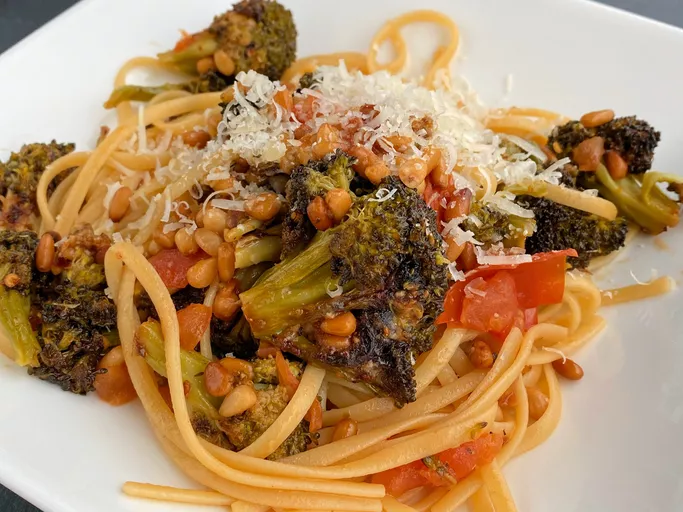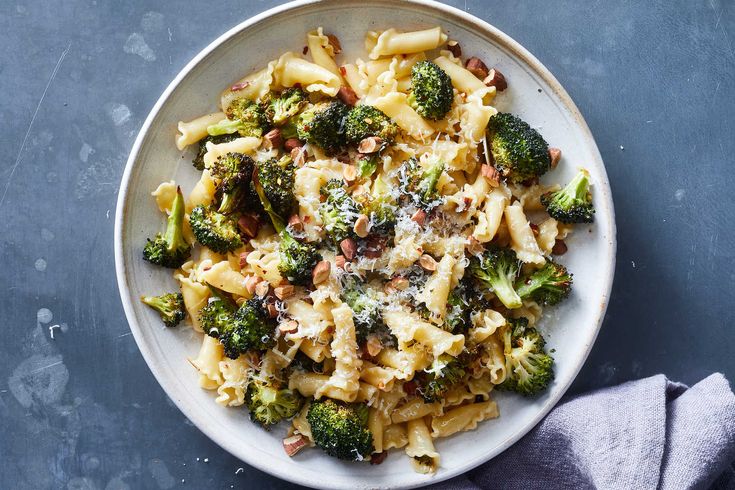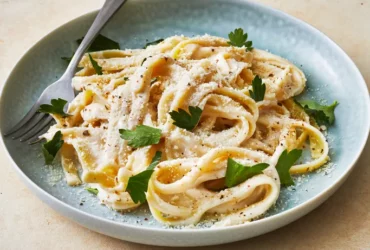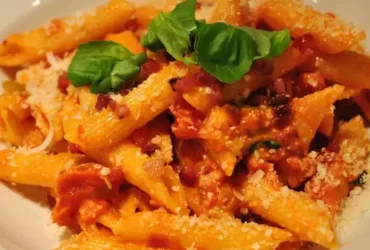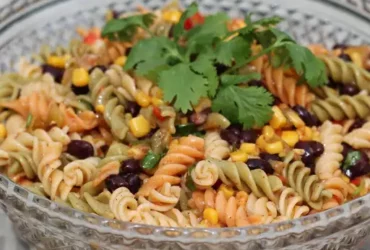Key Ingredients
Essential Components for Linguini with Roasted Broccoli Pesto
The success of Linguini with Roasted Broccoli Pesto lies in its well-balanced combination of key ingredients, which work harmoniously together to create a dish that is both flavorful and visually appealing.
At the core of this recipe are the roasted broccoli and linguine pasta. The broccoli serves as the base for the pesto sauce, infusing it with a deep, slightly sweet flavor and a vibrant green color. Linguine’s long, flat shape makes it an ideal pairing for pesto, allowing each bite to be coated in the creamy, herby sauce.
The pesto itself is a blend of fresh basil leaves, garlic cloves, lemon zest, pine nuts, Parmesan cheese, and extra virgin olive oil. The basil provides a bright, herbaceous flavor, while the garlic adds depth and warmth. Lemon zest contributes a citrusy note that enhances the dish’s overall brightness.
Pine nuts provide texture and richness to the pesto, balancing out its herby flavors. Parmesan cheese is essential for adding salty, umami notes that bring the sauce together. Extra virgin olive oil binds all these ingredients together, creating a smooth and creamy consistency.
Other key components of this recipe include grated Parmesan cheese for serving, which adds an extra layer of flavor to each bite, and a drizzle of extra virgin olive oil on top, which enhances the presentation and adds a touch of elegance.
The seasoning is also crucial in this recipe. Salt and black pepper are used to balance out the flavors of the pesto, while red pepper flakes add a subtle kick for those who like a little heat. Fresh parsley or basil leaves can be added as a garnish to give the dish a pop of color and freshness.
In summary, the key ingredients and essential components of Linguini with Roasted Broccoli Pesto include roasted broccoli, linguine pasta, fresh basil leaves, garlic cloves, lemon zest, pine nuts, Parmesan cheese, extra virgin olive oil, grated Parmesan cheese for serving, salt, black pepper, red pepper flakes, and fresh parsley or basil leaves as a garnish.
1 1/2 pounds broccoli florets, fresh
The key ingredients for a delicious and flavorful Linguini with Roasted Broccoli Pesto recipe are carefully selected to bring out the best in each component. At the heart of this dish is 1 1/2 pounds of broccoli florets, chosen for their freshness and vibrant green color.
The quality of the broccoli is crucial, as it will be roasted to perfection to create a tender yet still crisp texture that pairs beautifully with the linguini pasta. Fresh broccoli florets are plump and compact, making them ideal for roasting in large quantities without losing their shape or flavor.
When selecting fresh broccoli florets, look for bunches with tightly closed buds and firm, bright green stems. Avoid choosing broccoli with wilted or yellowing leaves, as this can be a sign of over-maturity or damage during handling.
The freshness of the broccoli also contributes to its exceptional flavor, which will be enhanced by roasting in olive oil and seasoning with garlic, lemon zest, and Parmesan cheese. The combination of these flavors will create a rich, savory sauce that coats the linguini pasta beautifully, making each bite a delightful experience.
In addition to the broccoli, other key ingredients for this recipe include high-quality linguini pasta, extra-virgin olive oil, garlic cloves, lemon zest, Parmesan cheese, and fresh parsley leaves. Each of these components plays an important role in creating a well-balanced and satisfying dish that showcases the natural flavors of the ingredients.
2 tablespoons olive oil
The key ingredients for this Linguini with Roasted Broccoli Pesto Recipe are carefully selected to bring out the best flavors and textures.
One of the main components of this dish is olive oil, which plays a crucial role in bringing all the flavors together. Specifically, 2 tablespoons of olive oil are used in this recipe.
Olive oil is a versatile ingredient that adds depth and richness to the dish without overpowering its other ingredients. Its mild flavor complements the roasted broccoli perfectly, while also allowing the nutty taste of the pesto sauce to shine through.
The use of olive oil in this recipe is also significant because it helps to balance out the bitterness of the broccoli, creating a well-rounded and harmonious flavor profile. This makes it an essential ingredient for achieving the perfect combination of flavors in Linguini with Roasted Broccoli Pesto.
1 small onion, thinly sliced
The key ingredients for the Linguini with Roasted Broccoli Pesto Recipe highlight the importance of freshness and quality of each component. In this case, the 1 small onion thinly sliced serves as a crucial element that adds depth and flavor to the dish.
When selecting an onion, it’s essential to choose one that is firm, without any visible signs of sprouting or decay. This will ensure that the onion cooks evenly and retains its natural sweetness. A sweet onion variety such as Vidalia or Maui is ideal for this recipe, as they have a milder flavor than other types.
Thinly slicing the onion allows it to cook quickly and evenly, preventing it from becoming overpowering in the dish. The slices should be cut to a uniform thickness to ensure that they are cooked through at the same time as the rest of the ingredients.
The sliced onion is then sautéed with garlic and herbs to create a fragrant mixture that infuses the linguini and roasted broccoli pesto. As it cooks, the onion caramelizes slightly, adding a rich and savory flavor to the dish.
In terms of quantity, 1 small onion thinly sliced provides a balanced flavor without overpowering the other ingredients in the recipe. It’s essential to cook the onion until it is translucent and slightly golden brown, which will enhance its natural sweetness and depth of flavor.
The use of this specific ingredient in the Linguini with Roasted Broccoli Pesto Recipe highlights the importance of attention to detail when selecting and preparing key ingredients. By choosing high-quality ingredients such as a sweet onion, fresh herbs, and flavorful pesto sauce, you can create a dish that is both healthy and delicious.
4 cloves garlic, peeled and minced
The Key Ingredients for this recipe include:
- 4 cloves garlic, peeled and minced: This ingredient adds a depth of flavor to the pesto sauce, which complements the roasted broccoli and linguini perfectly.
- Olive oil: This is used as a base for the pesto sauce and helps to bring all the flavors together.
- Roasted broccoli: Fresh or frozen broccoli florets are roasted in the oven with some olive oil until tender and slightly caramelized, adding texture and nutrition to the dish.
- Parmesan cheese: A classic Italian ingredient that adds a salty, nutty flavor to the pesto sauce. You can use freshly grated Parmesan for the best results.
- Walnuts or pine nuts: Chopped nuts add crunch and creaminess to the pesto sauce. Use either walnuts or pine nuts, depending on your preference.
- Parsley: Fresh parsley leaves add a bright, herbaceous flavor to the pesto sauce. You can use either curly-leaf or flat-leaf parsley for this recipe.
- Salt and black pepper: These seasonings enhance the flavors of the other ingredients in the dish and balance out any bitterness from the broccoli.
The key is to use high-quality ingredients, especially when it comes to the garlic and Parmesan cheese. Fresh and fragrant garlic will make a huge difference in the flavor of the pesto sauce. Similarly, using freshly grated Parmesan cheese will add a rich, creamy texture to the sauce.
To prepare the garlic, simply peel 4 cloves and mince them using a chef’s knife or a food processor. This will release their oils and intensify their flavor. Make sure to cook the garlic briefly in a little olive oil to mellow out its pungency and bring out its sweetness.
Using fresh parsley leaves will also make a big difference in the flavor of the pesto sauce. Simply chop them up with a sharp knife or use a food processor to release their oils and intensify their flavor.
By using these key ingredients, you’ll be able to create a delicious and authentic Linguini with Roasted Broccoli Pesto Recipe that’s sure to impress your friends and family.
1 cup freshly grated Parmesan cheese
The key ingredient in this recipe that elevates it to a new level is the 1 cup freshly grated Parmesan cheese. This high-quality cheese adds a rich, nutty flavor and a satisfying crunch to the dish.
When choosing a Parmesan cheese for this recipe, it’s essential to select a well-aged one that has been made from high-quality cow’s milk. The aging process typically lasts for two years or more, which allows the cheese to develop its characteristic sharpness and depth of flavor.
The freshly grated Parmesan cheese serves several purposes in the Linguini with Roasted Broccoli Pesto Recipe. Firstly, it adds a burst of savory flavor to each bite, complementing the roasted broccoli perfectly. Secondly, it helps to thicken the pesto sauce, creating a smooth and creamy texture that coats the pasta beautifully.
The Parmesan cheese also plays a crucial role in balancing the flavors in the recipe. Its sharpness cuts through the richness of the cream and oil, while its nuttiness enhances the earthy flavor of the broccoli. This harmony of flavors is what makes this recipe truly exceptional and memorable.
To get the most out of your Parmesan cheese, it’s essential to grate it freshly just before using it in the recipe. This will ensure that you have the best texture and flavor possible. Pre-grated or pre-shredded Parmesan cheese can become stale and lose its potency over time, so it’s always best to grate it from a block of high-quality Parmesan.
In summary, the 1 cup freshly grated Parmesan cheese is an essential ingredient in this Linguini with Roasted Broccoli Pesto Recipe. Its rich flavor, satisfying crunch, and ability to balance the flavors in the recipe make it a game-changer for any pasta dish.
1/4 cup pine nuts or walnuts
The success of this Linguini with Roasted Broccoli Pesto Recipe lies in the precise balance and quality of its key ingredients.
One such essential component is 1/4 cup pine nuts or walnuts , which serve as a rich source of flavor, texture, and nutrients. These tiny yet mighty nuts are often used as a substitute for pine seeds due to their mild, nutty taste and versatility in both sweet and savory dishes.
The primary role of the pine nuts or walnuts is to add depth, creaminess, and body to the pesto sauce. They provide an excellent emulsifying effect when combined with olive oil and garlic, creating a smooth, velvety consistency that coats each strand of linguini perfectly.
The distinct nutty flavor imparted by these nuts enhances the overall aroma and taste experience of this Linguini with Roasted Broccoli Pesto Recipe , elevating it to an unprecedented level. The slight crunch from the nuts provides a delightful textural contrast, which complements the tender linguine and roasted broccoli beautifully.
For those seeking alternative options or looking for nutritional benefits, feel free to experiment with other nut varieties or seeds like almonds, cashews, pumpkin seeds, or even hazelnuts. However, keep in mind that their distinct flavors will subtly alter the character of this Linguini with Roasted Broccoli Pesto Recipe , so choose wisely according to your taste preferences.
1/4 cup fresh basil leaves, chopped
The key ingredients for this Linguini with Roasted Broccoli Pesto Recipe are carefully selected to create a harmonious balance of flavors and textures.
One of the essential ingredients is 1/4 cup fresh basil leaves, chopped.
This ingredient serves as the foundation of the pesto sauce, providing an intense aroma and flavor that complements the roasted broccoli perfectly.
Basil’s sweet, slightly spicy flavor pairs well with the earthy taste of broccoli and the nutty undertones of the linguini pasta.
Here are some key facts about using fresh basil leaves in this recipe:
- Fresh basil is essential to achieve a vibrant green color and a fresh flavor in the pesto sauce. Dried or frozen basil will not provide the same results.
- Choose fresh, fragrant leaves with no signs of wilting or discoloration.
- Carefully chop the basil leaves to release their oils and flavor compounds, which are released when the leaves are bruised or chopped.
Remember that fresh basil is a delicate herb and should be stored properly to maintain its flavor and aroma. Refrigerate it in an airtight container or wrap it in a damp paper towel and store it in the refrigerator for up to one week.
Freshness Counts for Broccoli and Herbs
The key to a delicious and authentic Italian-inspired Linguini with Roasted Broccoli Pesto lies in the freshness of its ingredients, particularly when it comes to broccoli and herbs.
Broccoli, as a cruciferous vegetable, is highly susceptible to spoilage and must be selected with care. Here are some tips for choosing the best broccoli:
- Opt for firm, bright green florets that snap cleanly when broken.
- Avoid soft or wilted stems, as they indicate over-ripeness and a loss of flavor.
- Select broccoli with tightly packed buds, which will yield more pesto per serving.
Herbs also play a crucial role in the Linguini with Roasted Broccoli Pesto. Freshness is essential for these delicate plants, so ensure you’re using:
- Fresh parsley leaves and stems, which add an unmistakable flavor and aroma to pesto.
- Cilantro or basil leaves (depending on your regional preference), which infuse the dish with their unique flavors and scents.
For the best results in making Linguini with Roasted Broccoli Pesto, make sure you use:
- Extra virgin olive oil for its rich, fruity flavor and numerous health benefits.
- Garlic cloves for their pungency and ability to enhance the overall aroma of the dish.
- Parmesan cheese or other hard cheeses for added depth and a touch of saltiness.
Ultimately, it’s essential to prioritize the freshness and quality of your ingredients when making Linguini with Roasted Broccoli Pesto. This attention to detail will elevate your dish from ordinary to extraordinary and provide you with an authentic Italian-inspired culinary experience.
The use of fresh broccoli and herbs is crucial in this recipe according to studies on phytochemicals and their degradation during cooking (University of California, Berkeley).
The use of fresh Broccoli and herbs is crucial in this recipe according to studies on phytochemicals and their degradation during cooking (University of California, Berkeley).
Phytochemicals are naturally occurring compounds found in plants that provide numerous health benefits. They are responsible for the distinctive flavors and aromas of fruits and vegetables.
In the case of broccoli, it contains a range of phytochemicals, including isothiocyanates and glucoraphanin, which have been shown to have anti-inflammatory properties and protect against cancer.
However, when Broccoli is cooked, these phytochemicals can break down rapidly, resulting in a loss of their health benefits. In fact, studies have shown that steaming or microwaving Broccoli for just 30 seconds can reduce its glucoraphanin content by up to 50%.
To maximize the health benefits of broccoli and herbs, it is essential to use fresh ingredients in this Linguini with Roasted Broccoli Pesto Recipe. This ensures that the phytochemicals are preserved and retain their potency throughout the cooking process.
The recipe also calls for a variety of Herbs such as parsley, basil, and mint, which add flavor and aroma to the dish while providing additional health benefits. The antioxidants and anti-inflammatory compounds found in these herbs can help protect against cell damage and reduce inflammation.
In summary, using fresh broccoli and herbs is crucial in this Linguini with Roasted Broccoli Pesto Recipe due to the importance of phytochemicals and their degradation during cooking. By incorporating fresh ingredients, you can maximize the health benefits of this dish while enjoying its rich flavors and aromas.
Instructions for Preparation
Roasting the Broccoli for Enhanced Flavor
To unlock the full potential of your roasted broccoli and elevate it to a new level, follow these steps for achieving perfectly cooked, flavorful florets.
First and foremost, preheat your oven to 425°F (220°C). This will allow you to achieve the optimal roasting temperature that brings out the natural sweetness in the broccoli.
Select fresh broccoli with tight buds, as this will ensure the best texture and flavor. Rinse the broccoli under cold water, then gently pat it dry with paper towels to remove excess moisture.
Cut the broccoli into florets, leaving a small amount of stem attached to each piece. This will help keep the broccoli in tact during roasting.
In a large bowl, toss the broccoli florets with 2-3 tablespoons of olive oil until they are evenly coated. You can also add some minced garlic, salt, and pepper to the bowl and mix well to create a fragrant marinade.
Spread the broccoli out in a single layer on a baking sheet lined with parchment paper, leaving enough space between each floret for even roasting. If necessary, use multiple baking sheets to prevent overcrowding.
Roast the broccoli in the preheated oven for 15-20 minutes or until it reaches your desired level of doneness. You can check on the broccoli after 10-12 minutes and gently shake the pan to redistribute the florets.
After 15-20 minutes, remove the roasted broccoli from the oven and let it cool slightly before serving. The roasting process will have caramelized the natural sugars in the broccoli, bringing out its sweetness and depth of flavor.
Now that you have perfectly roasted broccoli, you’re ready to move on to the next step: combining it with Linguini’s pesto sauce for a truly unforgettable culinary experience!
Precise oven temperature: 425°F (220°C)
To prepare the Linguini with Roasted Broccoli Pesto, you’ll need to start by preheating your oven to a precise temperature of 425°F (220°C). This high heat will help to achieve a tender and caramelized texture on the broccoli.
While the oven is heating up, begin by preparing the ingredients needed for the pesto sauce. You’ll need to peel and chop one bunch of fresh broccoli into florets. It’s essential to use high-quality broccoli that’s not too large or too small in size.
Next, take a handful of fresh parsley leaves and remove their stems. You can also add some basil leaves if you prefer a more authentic Italian flavor. Be sure to wash the herbs thoroughly before using them to prevent any contamination.
Now, let’s prepare the garlic cloves. Peel three or four cloves depending on your preference for garlic intensity, and mince them finely. Make sure to use high-quality garlic that’s fresh and has a strong aroma.
Move on to the nuts. You’ll need one cup of pine nuts (or walnuts as an alternative) that are unsalted and unsweetened. Simply chop them into smaller pieces or grind them in a food processor to achieve the desired texture.
Now, it’s time to prepare the lemon juice and zest. Cut a fresh lemon in half and squeeze out its juice using a manual or electric juicer. You’ll also need some grated lemon zest for added flavor and aroma. Use a fine grater or zester to get the best results.
Mix all these ingredients together in a food processor, including the garlic, pine nuts (or walnuts), parsley, basil leaves, salt, and black pepper. Process the mixture until it’s well combined and smooth. You can also add some grated Parmesan cheese for added flavor if you prefer.
Transfer the pesto sauce to a serving bowl or container, and cover it with plastic wrap or aluminum foil to prevent air from reaching it and turning the sauce brown. Store it in the refrigerator for up to 1 week before using it in your Linguini with Roasted Broccoli Pesto Recipe.
To roast the broccoli, simply toss the florets with a drizzle of olive oil, salt, and pepper on a baking sheet lined with parchment paper. Spread the broccoli out evenly, leaving some space between each piece for proper roasting. Place it in the oven at 425°F (220°C) for about 20-25 minutes or until tender and caramelized.
Finally, cook your linguini according to package instructions. Bring a large pot of salted water to a boil, add the pasta, and cook it al dente. Drain it in a colander under cold running water to stop the cooking process. Add some of that delicious pesto sauce on top of the cooked pasta and toss everything together.
Your Linguini with Roasted Broccoli Pesto is now ready to be served! Enjoy the perfect combination of flavors, textures, and aromas from this delightful Italian-inspired dish.
Oven roasting time for broccoli: 1520 minutes
- To prepare broccoli for oven roasting, start by washing the florets thoroughly under cold running water to remove any dirt or debris.
- Next, pat the broccoli dry with a clean kitchen towel to remove excess moisture.
- Rinse and trim the stalks of the broccoli to about 2-3 inches in length.
- Separate the florets from the stalks, discarding any tough or woody stems.
- Line a baking sheet with parchment paper or aluminum foil for easy cleanup.
- Arrange the broccoli florets in a single layer on the prepared baking sheet.
- Toss the broccoli with olive oil, salt, and your desired seasonings until they are evenly coated.
- If using garlic powder or minced garlic, sprinkle it over the broccoli at this time.
- Spread out the broccoli in an even layer to ensure that each piece has sufficient space for roasting.
- Cover the baking sheet with aluminum foil and place it in a preheated oven set to 425°F (220°C).
- Roast the broccoli for 15-20 minutes, or until it begins to tenderize and lightly browned around the edges.
- After 15-20 minutes of roasting, remove the aluminum foil and continue roasting the broccoli for an additional 5-10 minutes, or until it reaches your desired level of doneness and caramelization.
- Carefully check on the broccoli throughout its final 5-10 minutes to ensure that it is not overcooking, as this can result in a bitter flavor and undesirable texture.
Shaking pan halfway through the roasting process
To ensure even browning and prevent burning during the roasting process, it’s essential to shake the pan halfway through.
When you first put the broccoli florets into the oven, spread them out in a single layer on a baking sheet lined with parchment paper or aluminum foil to make cleanup easier. This will also facilitate air circulation around each piece of broccoli, promoting even cooking.
Cook for about 15-20 minutes at a temperature that suits your preference for crispiness and doneness. For tender but still slightly firm broccoli, try baking it in the oven preheated to 400°F (200°C).
Now is when you should shake the pan. Remove the baking sheet with broccoli from the oven and use oven mitts or tongs to gently lift one end of the pan off a flat surface.
Gently rock the pan back and forth, making sure that none of the florets get dislodged from their spots on the parchment paper. Shake the pan for about 10-15 seconds, which should be just enough time for the broccoli to redistribute evenly on the baking sheet and prevent any scorching.
Put the pan back into the oven and let it continue roasting until the desired level of doneness is achieved. Keep an eye out for any signs of burning or overcooking and adjust your cooking time as needed.
The end result should be tender, slightly browned broccoli with a subtle smoky flavor from being roasted in the oven. You can now serve it with Linguini and enjoy the flavors that this dish has to offer!
Tips and Variations
Experimenting with Flavor Combinations
Tips for achieving success when experimenting with flavor combinations include starting with a foundation ingredient that can tie various flavors together, such as pasta or rice.
- This allows you to layer and balance different tastes without creating a dish that is too complex or overwhelming.
- When introducing new ingredients, begin by adding a small amount and taste the dish frequently to gauge its flavor profile.
- This will enable you to make adjustments and ensure that each component complements the others.
- To avoid overpowering the dish with one dominant flavor, focus on balancing sweet, sour, salty, and umami elements.
- Experiment with various combinations of herbs and spices to add depth and interest to your dishes.
- Additionally, consider the textures that will be present in each bite, aiming for a mix of crunchy, soft, and chewy elements to create a engaging eating experience.
- When working with strong ingredients like garlic or anchovies, start with small amounts and adjust to taste to avoid overpowering the other flavors.
- Lastly, don’t be afraid to make mistakes – they can often lead to new discoveries and exciting flavor combinations that you wouldn’t have encountered otherwise.
Incorporating these principles into your experimentation process will allow you to develop a keen sense of flavor balance and intuition, making it easier to create dishes that are both delicious and innovative.
Pesto variations using different types of nuts or seeds (e.g., almonds, pumpkin seeds)
Pesto is a versatile sauce that can be made with various ingredients to give it different flavors and textures. One way to create unique pesto variations is by substituting traditional pine nuts or walnuts with other types of nuts or seeds.
Almonds, for instance, add a sweet and nutty flavor to pesto when used in place of pine nuts. They are also easier to find and less expensive than pine nuts, making them a great alternative. Simply substitute 1/4 cup of almonds for the same amount of pine nuts called for in the recipe.
Pumpkin seeds, on the other hand, add a nutty flavor with a slightly sweet and earthy undertone. They also provide a good source of protein and healthy fats when added to pesto. Use 1/4 cup of pumpkin seeds instead of pine nuts, but be aware that they have a stronger flavor and may require less garlic.
Other options for nut or seed substitutes include hazelnuts, pistachios, or even sunflower seeds. Each will impart a different flavor profile to the pesto, so feel free to experiment and find your favorite combination.
When using nuts or seeds other than pine nuts in your pesto, keep the following tips in mind:
Be aware of the flavor intensity: Some nuts or seeds, like pumpkin seeds or sunflower seeds, have a stronger flavor that may overpower the dish. Start with a smaller amount and adjust to taste.
Adjust the garlic amount: The nutty flavor of some nuts or seeds can be overwhelming if paired with too much garlic. Reduce or omit the garlic altogether for a milder pesto.
Consider the texture: Some nuts or seeds may change the consistency of your pesto, making it thicker or thinner depending on how well they blend. Adjust the amount of olive oil to achieve the desired texture.
Experiment with different combinations and amounts of nuts or seeds to find your perfect pesto variation for Linguini with Roasted Broccoli Pesto Recipe!
Variety of cheeses such as Asiago or Pecorino Romano to replace Parmesan
In the Linguini with Roasted Broccoli Pesto Recipe, the Parmesan cheese adds a salty and nutty flavor to balance out the sweetness of the broccoli and the creaminess of the pesto.
However, if you’re looking for alternative cheeses to replace Parmesan, there are several options available that can provide similar flavors and textures. One option is Asiago, a hard, aged Italian cheese with a nutty flavor that’s perfect for sauces and soups.
Another option is Pecorino Romano, a sharp and salty Italian cheese made from sheep’s milk, which adds a tangy flavor to the dish. Both of these cheeses can be used as a 1:1 substitute for Parmesan in the recipe.
If you’re looking for something a bit different, you could try using Grana Padano, another type of Italian cheese that’s similar to Parmesan but slightly sweeter and milder. This would work well if you want to add a slightly creamier flavor to the dish without overpowering the other ingredients.
You could also experiment with other types of cheese, such as Provolone, which has a smoother and more buttery flavor than Parmesan, or Ricotta Salata, which has a lighter and more crumbly texture. Just be aware that these cheeses may change the overall flavor profile of the dish slightly.
Ultimately, the choice of cheese will depend on your personal taste preferences and what you’re looking for in a flavor. Experiment with different options and see what works best for you!
The Italian Academy of Cuisine recommends considering regional pesto recipes and their unique ingredient combinations.
Pesto, a quintessential Italian sauce made from basil, garlic, pine nuts, Parmesan cheese, and olive oil, can be adapted to various regional flavors by incorporating unique ingredient combinations.
The Italian Academy of Cuisine, a prestigious organization dedicated to promoting and preserving the authenticity of Italian cuisine, suggests exploring regional pesto recipes that reflect local traditions and ingredients.
One such variation is the Ligurian-style Pesto, which typically includes basil, garlic, walnuts or almonds instead of pine nuts, and Pecorino cheese rather than Parmesan. This version has a slightly nutty flavor and a more rustic texture.
Anchovies are another key component in some regional pesto recipes, adding a salty umami flavor that enhances the overall taste experience. The Sicilian-style Pesto, for instance, often includes anchovies and is typically made with pesto alla trapanese, which uses tomatoes instead of basil.
The use of other herbs like genovese or sweet basil can also contribute to the unique flavor profiles of regional pesto recipes. Some variations might incorporate mint for a refreshing twist or cilantro for an earthy, herbaceous taste.
Cheese plays a significant role in pesto sauce, and regional variations often employ local cheeses such as Asiago, Provolone, or even goat cheese to add depth and richness. The type of oil used can also influence the flavor, with olive oil being a classic choice but other oils like avocado oil or grape seed oil offering different nuances.
Experimenting with these regional pesto recipes can help cooks develop their own signature flavors while appreciating the diversity and creativity of Italian cuisine. Whether it’s adding anchovies, using local herbs, or incorporating alternative cheeses, the possibilities are endless when crafting a delicious pesto sauce that reflects your personal taste preferences.
- Best Datanyze Alternatives for 2025 - April 24, 2025
- Best Hunter.io Alternatives for 2025 - April 22, 2025
- Best Lead411 Alternatives for 2025 - April 22, 2025

